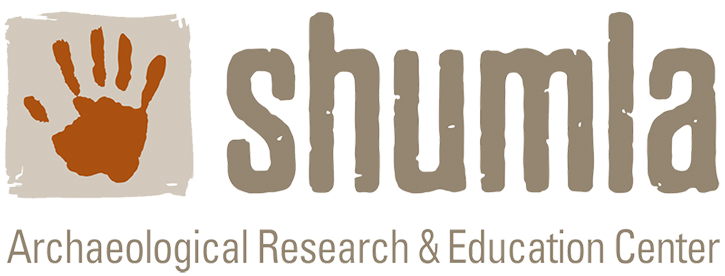Our Research Plans
The Mystery of Pecos River Style Art
We do not know the exact age or time span of Pecos River Style (PRS) murals. We have a small suite of radiocarbon dates indicating that some of the murals were produced as early as 3,500-4,000 years ago, during a time that the archaeologists call the Archaic. The people of the Lower Pecos gathered plants and hunted game, did not build permanent structures, and moved often, usually on a seasonal basis. Their possessions were limited to what they could carry or conveniently cache.
Observers of PRS art face a mystery—a small society in a region with no historical evidence for agriculture, permanent structures, or village life produced monumental works of art. And yet, there appears to be an intricate thread of symbols and ideas connecting these Archaic period murals to the later art of the great civilizations of the Americas. Are hunter-gatherers capable of producing highly structured compositions with complex visual vocabularies that spoke to the viewers? In certain circles, this is still debated.
Carolyn Boyd, a professor at Texas State University and founder of Shumla, is convinced they did, and she carries her conviction to the next level.
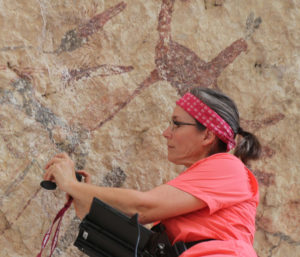
Carolyn Boyd using a digital microscope at Rattlesnake Canyon.
She argues that Indigenous peoples can still read the messages in PRS art, consistent with the reading of the messages 3,000-4,000 years ago. She has already identified several pictographic elements relating to the myths and narratives of later Mesoamerican religions (Boyd and Cox 2016). The broader implication is that Indigenous belief systems have deep roots extending back thousands of years.
Some scholars, most notably Alfredo Lopez-Austin, have argued for the existence of an Archaic hard center (nucleo duro) of basic beliefs that cross time, cultures, and geography throughout Mesoamerica and much of the greater Southwest. Is PRS mural art a surviving manifestation of core beliefs that formed the basis for later Aztec, Toltec, and Olmec religions? If this is true, then regardless of group affiliation, any person with a working knowledge of the transcendent myths informing the art could read the murals.
The key to finding the answers to these questions is to extract as much information as possible from the art itself. Fortunately, a mural contains multiple layers of information which we intend to approach by tapping into two research traditions—the sciences and the humanities.
Science and the Humanities
Scientific methods and technologies reveal much about the organizational structure of the murals, the chemical composition of the paints, and the age of the murals. Informed by scientific studies, a humanities approach probes further into the heart of the artists and the society in which they produced the art. We will utilize the expertise of archaeologists, rock art experts, archaeological chemists, Indigenous consultants, ethnographers, ecologists, geologists, and data managers, highlighting the interdisciplinary fabric of archaeology. Each approach informs the other. As this project unfolds, we will show how our pursuing answers from a scientific perspective, and from a humanities perspective, allows us to mine far more information from the art than previously thought possible.
Partial funding for the research comes from the National Endowment for the Humanities (NEH) and the National Science Foundation (NSF). The two research designs ask different, but complimentary sets of questions.
Research Designs
National Endowment for the Humanities (NEH)
and National Science Foundation (NSF
Put simply, the NEH research strives to decode the message in the medium. The NSF research focuses on the timing and the context of that message.
NEH: Origins and Tenacity of Myth, Ritual, and Cosmology in Archaic Period Rock Art of Southwest Texas and Northern Mexico
At its core, this is a study in iconography visual signs—how they are constructed, how they are strung together into a composition, and what they mean. The underlying premise, already demonstrated by Boyd and others, is that these murals contain a rich source of accessible information about the people who produced them.
We will document the artistic methods used by the ancient muralists. We seek to understand the complex graphic vocabulary contained in the murals. We want to read the stories told in each mural.
And we will take elaborate reconstructions of these murals and share them with contemporary Native Americans to obtain their perspective, rooted in generations of knowledge, understanding, and practice.
The NEH project is separated into two stages, an archaeological and an ethnographic stage. The archaeological stage assembles information for the ethnographic stage.
Archaeological Stage: During the archaeological stage we will collect data at three large and complex mural sites, Halo Shelter, Panther Cave, and Rattlesnake Canyon, to answer the following questions:
- What other pictographic elements within PRS murals graphically represent Archaic period cosmological concepts?
- Are these PRS murals compositional in structure and narrative in function, as demonstrated at the White Shaman site (Boyd and Cox 2016)?
- Are there consistent rules of paint application at multiple mural sites across the region, as demonstrated at the White Shaman site (Boyd and Cox 2016)?
- What mark-making techniques did the artists use to communicate information (Boyd and Busby 2021)?
Boyd will synthesize the field and laboratory data to draw three renderings in Adobe Photoshop. These are not just photographs or drawings, but visual databases. These scale renderings will reflect the order of paint application used by the ancient muralists. Within the digital copies of the drawings, each figure will contain its own pertinent metadata, including attribute data and georeferencing.

Diana Rolón and Tim Murphy setting up the total data station.
The last step to prepare for the ethnographic stage is to produce hard copies in banner form, each measuring about 3-feet tall and 8-10 feet long, for transport to Mexico.
Ethnographic Stage: The ethnographic team is led by Stacy Schaefer and Jim Bauml, two ethnologists with 40 years of experience working with the Huichol people. Here we collect a different type of data, seeking to see if contemporary people can still read and understand the art. Accompanied by Carolyn Boyd and Phil Dering, Schaeffer and Bauml will show hard copies of the mural art to consultants—elders, artists, shaman—in the community, for comment.
- Are PRS pictographic symbols recognizable to modern indigenous societies whose beliefs emerged from ancient Mesoamerican traditions?
- Can the Huichol offer insights into the artistic process of PRS mural painting or offer insights into
patterns in PRS and the visual narratives they portray? - What do they see that we have missed?
The NEH study will give us a chance to see the world as the ancient hunter-gatherer people saw it. We can get a glimpse of this world, buzzing with life and histories related in the mythology these murals still hold.
NSF: Layers of Meaning – Pictography Stratigraphy and Chronological Modeling
We believe that a major event or series of events triggered the production of PRS murals. Was it climate change? Was it movement of people or ideas? Or was it the combination of many factors that spilled over into a creative explosion of wall art?
We cannot begin to answer those questions until we have a better idea of when and for how long the murals were painted. This project will generate an unprecedented suite of radiocarbon dates useful for understanding the timing and development of PRS art. It will allow us to study the art in the context of the rest of the material culture. We should be able to align mural production with changes in the environment, population, social structure, and technology in or adjacent to the region.
Field: The NSF project begins with fieldwork, supervised by the two co-principal investigators, Carolyn Boyd and Karen Steelman.
This is a study of paint stratigraphy. We select figures and motifs repeated across the region at many sites—important images in the visual lexicon. We study in detail the context of these figures, how they fit within the mural. We study the layering of paint colors using digital microscopy, within and around the
figures, to determine the order in which the mural was painted.
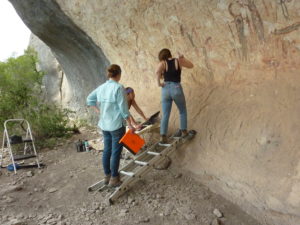
Las tres amigas (l to r), Audrey Lindsay, Diana Rolón, and Ashley Busby, using a digital microscope to determine paint layering.
We will choose several figures where the paint layers are interwoven, like a tapestry. If we can date just one of the layers in the tapestry, we have secured a date for a whole section of the mural. In that spot we collect tiny samples of paint.
Laboratory: Then work begins in the laboratory. Shumla’s archaeological chemist, Karen Steelman, will prepare paint samples for radiocarbon isotope measurement in order to obtain age determinations. Working with Shumla team members, she will build statistical models of the chronology to produce a temporal history or chronology of the art and to look for answers to the following questions:
- When did PRS mural production begin and end?
- Do materials, techniques, and production methods change?
- Does the iconography change during the time of mural production?
- How does the chronology of the art relate to other major cultural developments in adjacent regions, such as Mesoamerica?
- Does the chronology of the art align with changes in climate?
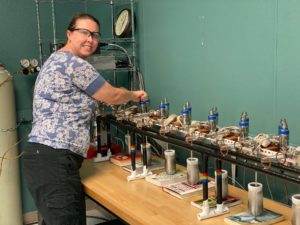
Karen Steelman working at the multi-chamber plasma oxidation apparatus.
Conducted together, the NEH and NSF projects will generate and share data that will preserve not just the images, but the history and ideas carried within the images.
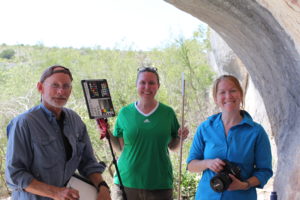
Phil Dering, Karen Steelman, and Audrey Lindsay pausing for a photo op while collecting figure photography.
